Ever since my days as a young biologist, one of my favourite creatures of all time has been the amazing Komodo Dragon – largest lizard in the world! I have since had the good fortune of visiting the UNESCO-listed Komodo National Park in Indonesia.
Komodo dragons are dangerous predators. You can see Komodo Dragons in Komodo National Park, but should only go with trained Park Rangers. Komodo dragons can weigh up to 300 lbs (136 kilos) and reach up to 10 ft (3 m) in length. They have shark-like teeth with sharp serrated-edges meant for tearing, not chewing.
They are immensely powerful and can kill a large animal with one venomous bite! Read on to discover how one bite from a Komodo dragon (Varanus komodoensis) can bring down large animals such as adult deer or buffalo!
Where do they live?
I was fortunate to visit Komodo Island on a world cruise with Holland America as a science lecturer onboard the ms Amsterdam. As we anchored in the wide bay, the island beckoned like a scene from The Lost World, with green, forested slopes and steep mountain ridges. We were in for a treat: open savannah, palms, cockatoos screeching… and real live Dragons!
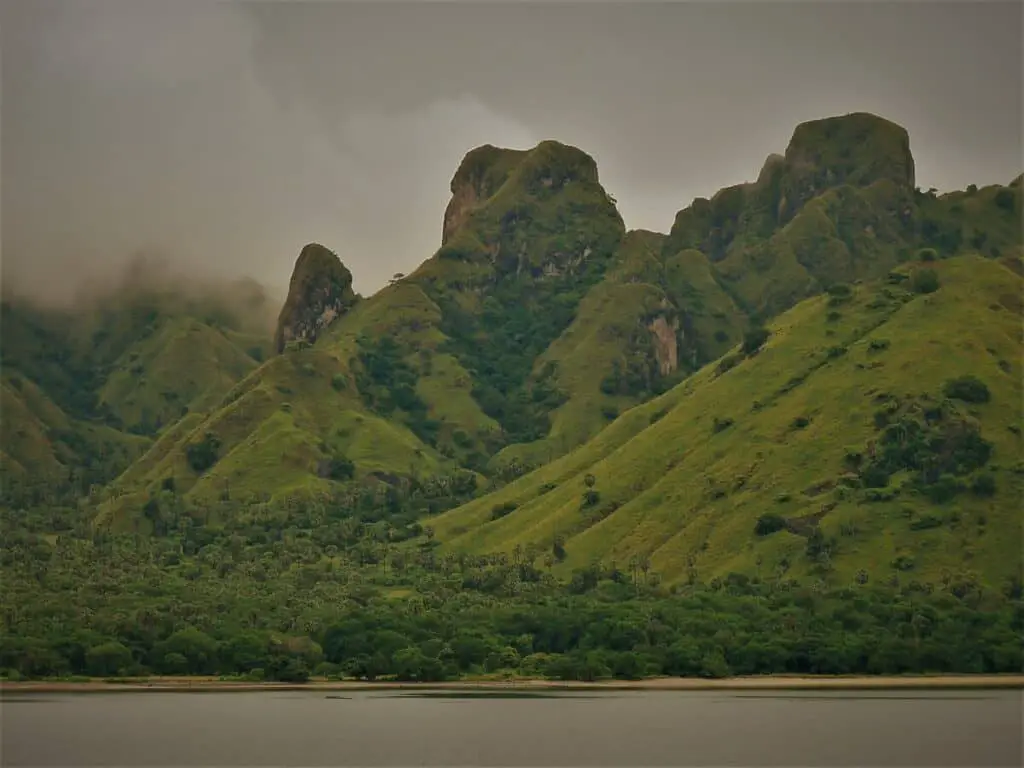
According to UNESCO, there are about 1,700 dragons on Komodo island, with about 5,700 dragons in total spread across the islands of Komodo, Rinca, Gili Motong and parts of Flores.
Thinking of visiting? When is the best time to visit?
I don’t think there’s a bad time to visit Komodo National Park… although the dry season might be best, from April to December.
What do they eat?
These giant lizards prey on anything they can scavenge or kill, including large mammals such as adult water buffalo, Timor deer, goats, monkeys, and wild pigs. AND smaller dragons. Dragons under 5-6 feet (2 m) live largely in the trees to avoid predation from… you guessed it… large dragons, which could be their own parents! Young dragons feed on smaller creatures such as lizards, snakes and birds.
Once they find some food, they will gorge themselves and can apparently consume up to 80% of their body weight in one meal (sounds like a bit of a stretch!). And they are fast eaters. The intramandibular hinge allows them to spread their jaws amazingly wide. Wide enough to swallow a whole pig. Yes, a large Komodo dragon can gulp down an entire wild pig in less than 20 minutes. Burppp!!
The largest verified wild Komodo dragon was 10.3 ft (3.13 m) long and weighed 366 lb (166 kg), including its undigested food.
How do they hunt and kill their prey?
The Komodo dragon hunting strategy is unique and offers some amazing adaptations. They use stealth and are best suited to ambushing prey, waiting patiently for hours or days alongside game trails and water sources. Most attacks are unsuccessful. Once they do get a good bite – causing maximum bleeding and tissue damage – the dragon typically takes a “jaws-off” approach. They won’t try to kill a large animal on the spot. They “grip and rip,” causing as much damage as they can, and then they wait.
It can take up to four days, but eventually the animal will collapse from a combination of blood loss, toxic shock, and infection.
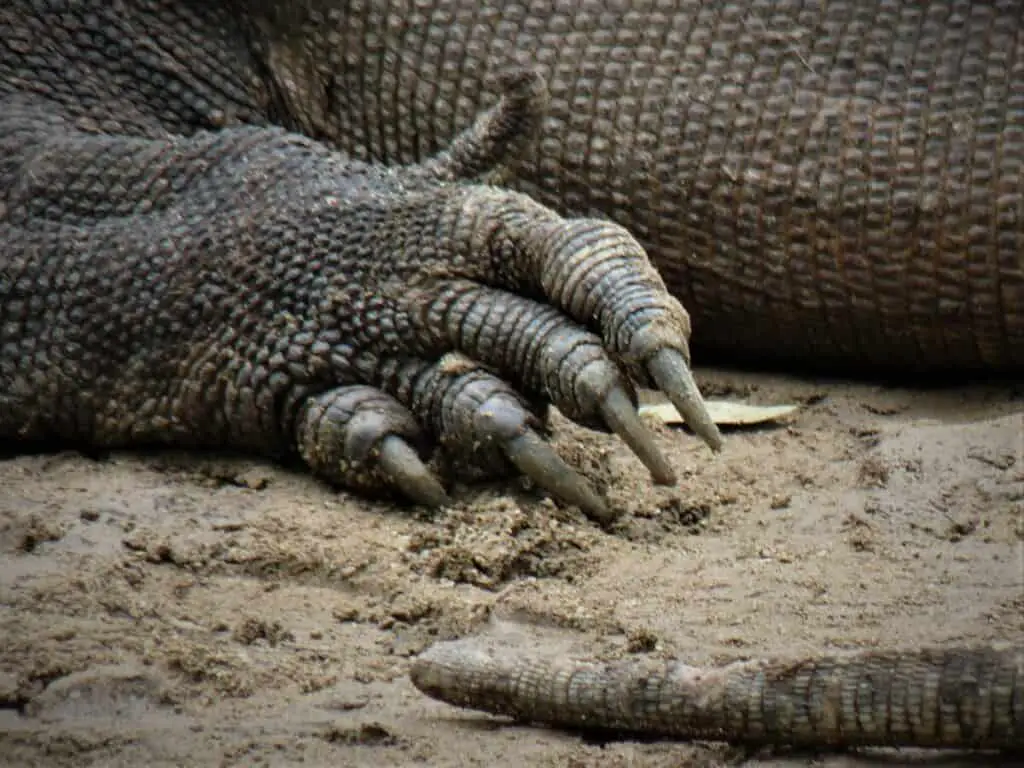
Dragon saliva is crawling with colonies of dangerous bacteria. Until recently, it was believed that one bite would introduce enough bacteria to cause septicaemia and death by blood-poisoning. Thanks largely to research by Dr. Bryan Fry, we now know that dragons also have venom with anti-coagulant properties, contributing to massive blood-loss once the prey is bitten. (see Dr. Bryan Fry at venomdoc.com). Dr Fry refers to the notion that dragons can kill an adult water buffalo with only the bacteria in their mouths as a complete myth.
Dragons under 7 feet can be some of the most successful hunters, but often lose their prey to large dragons. Komodos can smell blood up to 5 miles away… consequently the big ones just hang around until they catch a whiff of blood and guts and then mosey on over to gorge themselves. In the world of lizards, size is everything! The smaller ones simply have to wait their turn – if there’s anything left.
When you are a dragon, offal isn’t awful — it’s mighty nice to find something dead and decomposing now and then!!
Why do Komodos have forked tongues?
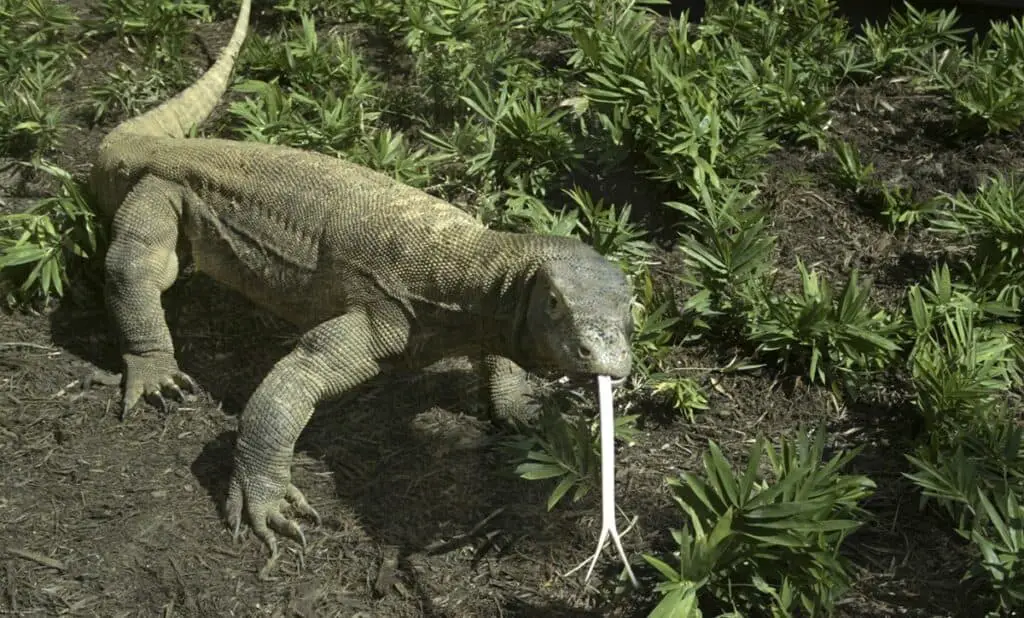
Komodo dragons, like many other reptiles, rely primarily on their tongue for taste and smell. If you watch dragons carefully, you will see that they often dart their long, forked tongues in and out of their mouths. They access taste and smell by using the Jacobson’s organ, rather than by using their nostrils.
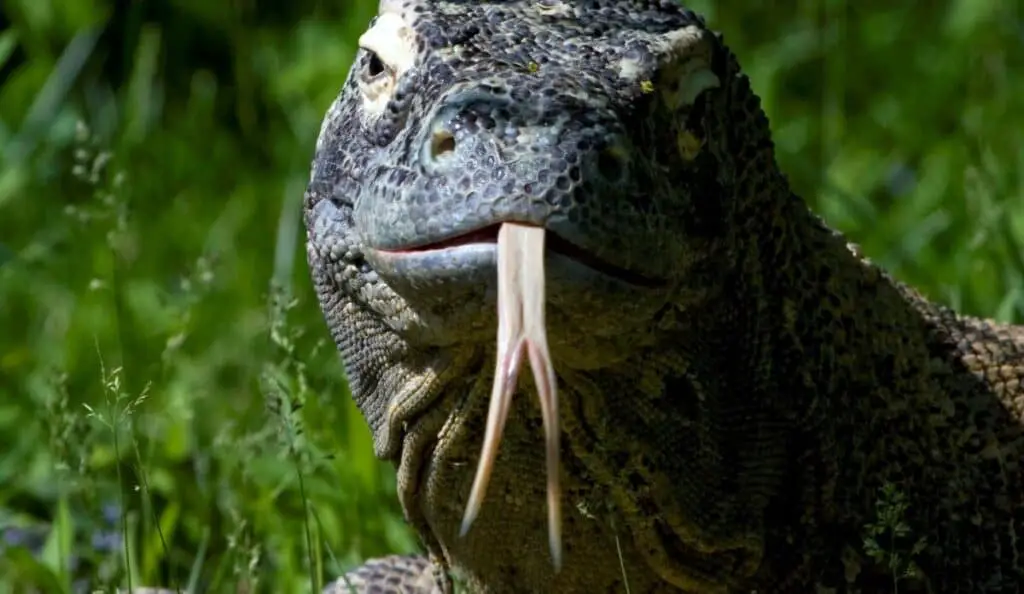
Each time that ultra-long tongue slides out, the tips pick up molecules from the air. When the tongue slides back inside the mouth, the dragon pokes the tips into two pockets in the roof of its mouth. Nerves in the Jacobson’s organ, also called vomeronasal organ, sense any odors and provide the dragon with a detailed picture of any potential meals nearby…or potential mates or competitors.
The two tips of the forked tongue provide a 3-dimensional perspective on the chemicals in the air, so the dragons can perceive the direction a smell is coming from. This allows them to hone in on a kill or carcass from a distance no matter the direction of the breeze.
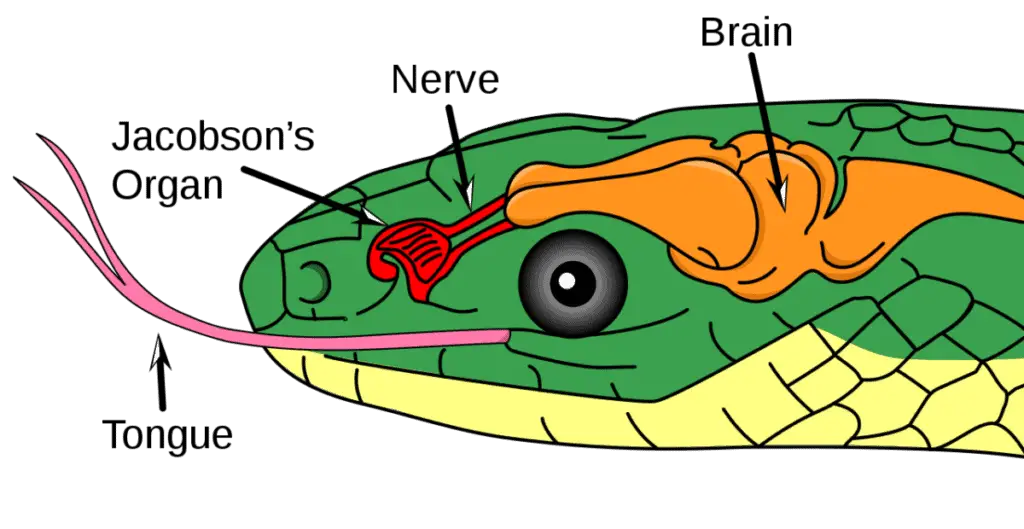
Did you know that Komodo Dragons also have forked penises? Read my article on the fascinating sex lives of these giant lizards. Sexual or asexual – dragons can do it! Males and sperm are optional.
Venom: the Komodo Dragons’ Secret Weapon
Using an MRI machine on a dead Komodo, Dr. Fry found complex venom glands in the lower jaw, with 6 ducts on each side leading to openings between the teeth. Rather than being injected, the torn flesh is flooded with venom.
There are over 600 toxins in Komodo venom, rivaling the venom of many snakes. This toxic mix of chemicals can cause internal hemorrhaging, prevent blood from clotting and cause muscle contractions and paralysis.
In addition to the anti-coagulant properties, the venom packs some real physiological punch. Dr. Fry calculated that only 4mg of venom protein could make a 40kg deer go into toxic shock. A typical dragon would have eight times this amount available in its venom glands.
Grabbing a Dragon by the Tail – A Personal Story
After our arrival at Komodo National Park, we were given a brief overview of the route for our one hour trek. Our group of approximately 20 people was accompanied by a Park Ranger and his assistant, both armed with 6 ft long sticks with forked ends. No firearms or even firecrackers…just forked sticks! We soon discovered that forked-sticks are really helpful when facing an over-eager dragon.
The first dragon we met was asleep on the trail… he was only about 7 or 8 ft long. We were asked to go around him so as not to disturb his nap. Ordinarily I don’t like to hike off-trail, but something in my genetic makeup urged me to let this sleeping dragon lie.
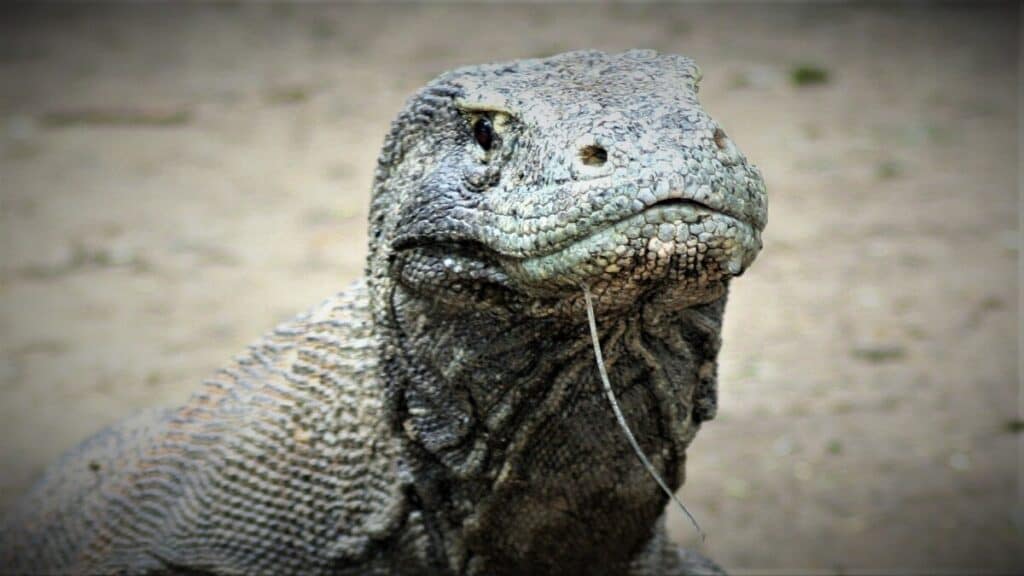
Our next dragon was much bigger and built like a reptilian 200 lb bulldog. His two-foot long forked tongue flicked the air to get a good sniff of us well-fed cruise ship passengers. His colleagues did the same. We found ourselves standing in a forest clearing in the midst of a small pack of huge, rather rotund dragons… five in fact. Lucky for us they appeared lethargic and sleepy. My hope was that they were busy digesting a previous meal of pig or deer and thought we looked too agile and alert.
Turns out the big ten footers aren’t the most dangerous; the 6-7 footers are the real hunters because they are lithe and quick on their feet. (Reminder: Dragons under 3 years old and 4-5 feet long hang out in the trees because mom and dad don’t mind snacking on youngsters when they can catch one.) Sure enough, when I looked around I spotted a 4 or 5-footer up in a nearby tree, keeping an eye on us tourists.
I must admit that I was a surprised to find that we could wander so close to these dangerous predators without any fencing or barriers of any kind. The rangers kept urging us to move slowly, to avoid making noise, and – above all – not to run! Our ranger had a favorite phrase as he herded us along the path, “Quick, quick…but slow, slow!”
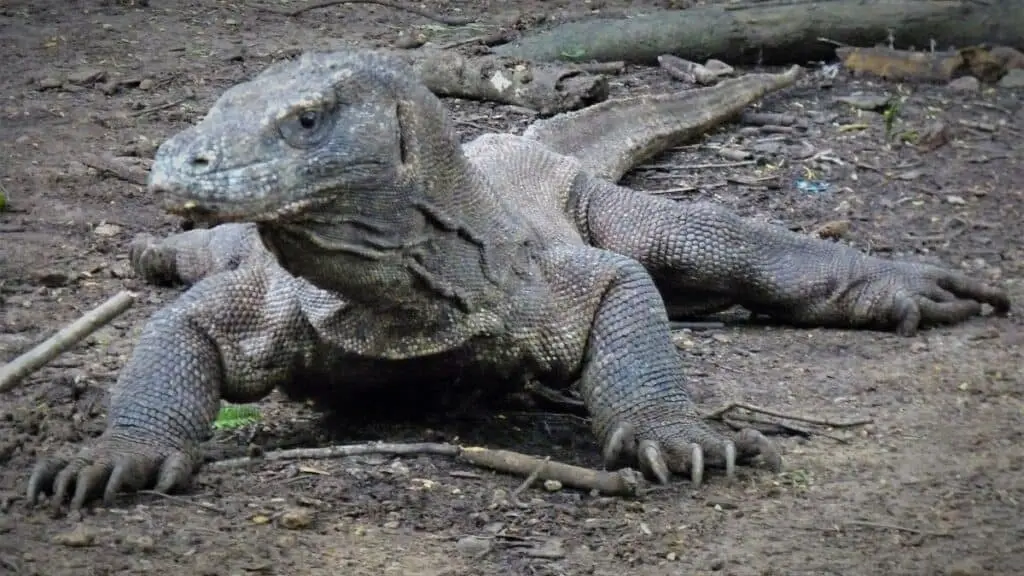
The folks in one of the other groups were extremely fortunate – they got to experience a lot more excitement!
Apparently, one of the photographers got too close to a dragon and his loud camera shutter caught the lizard’s attention. With surprising speed, the dragon suddenly rose from his repose and began slithering toward the man for a closer look. This set off a mini-stampede of cruise passengers looking to make a quick retreat!
At that point the ranger jumped into the fray and grabbed the dragon by the tail to slow it down! The assistant rangers were busy using his forked stick to fend off the other end with all the shark-like teeth.
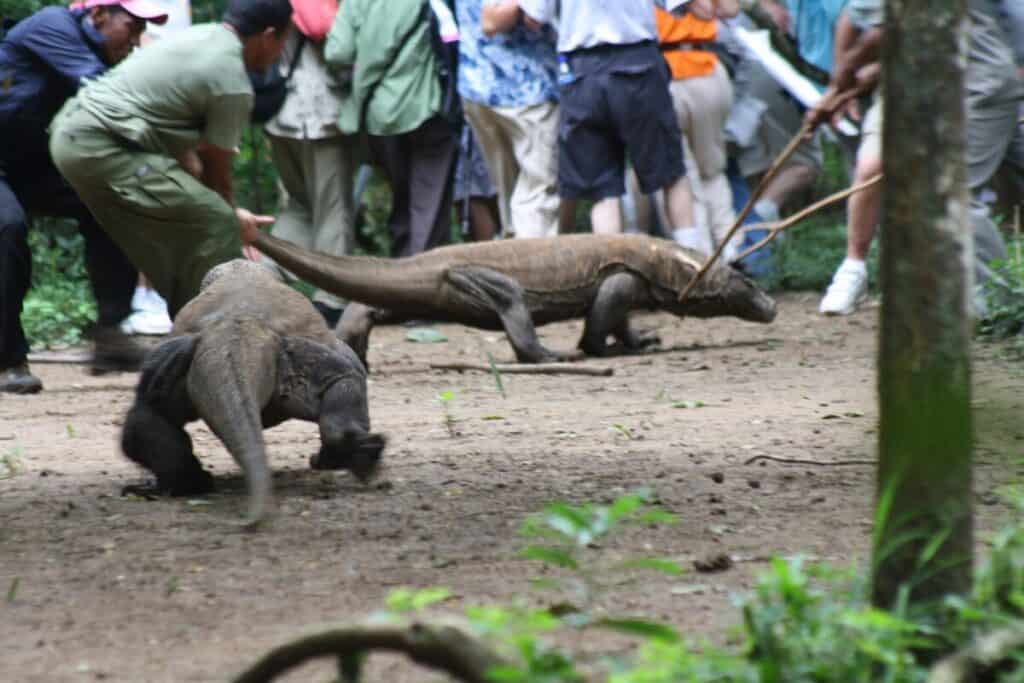
There you have it – now we know how those forked sticks can come in handy in fending off living dragons! Of course, there’s a bit of technique involved.
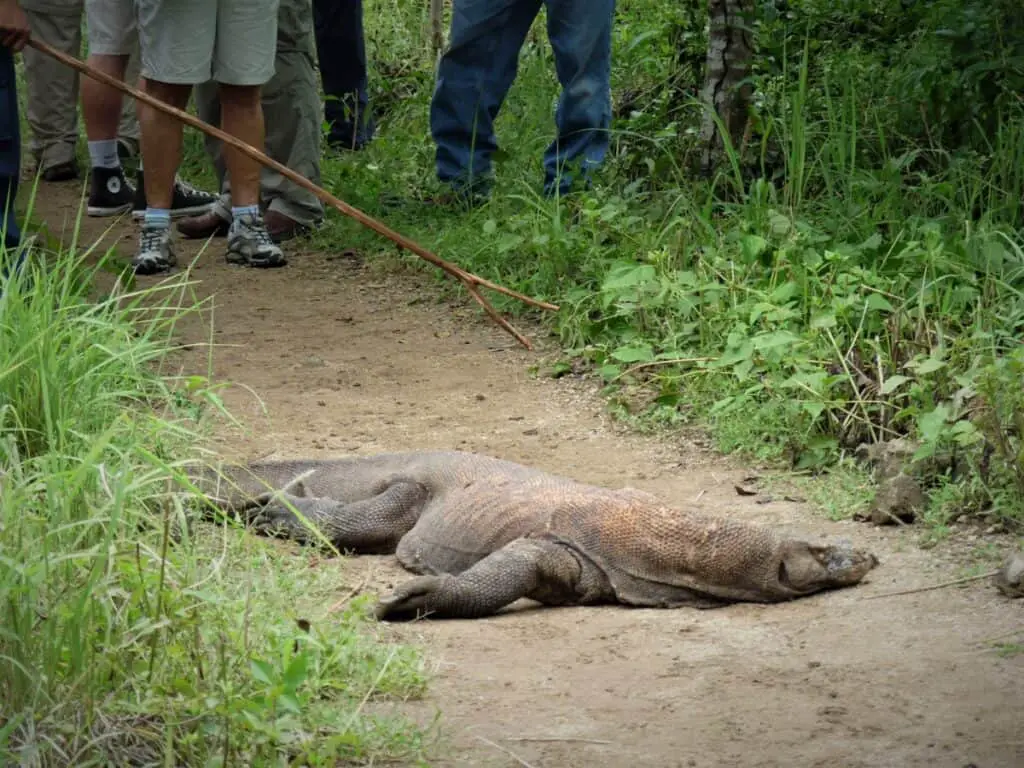
The Gear We Love to Travel With
We love to travel in search of exceptional wildlife viewing opportunities and for life-enhancing cultural experiences.
Here is the gear we love to travel with for recording our adventures in safety and comfort:
- Action Camera: GoPro Hero10 Black – we find these waterproof cameras are invaluable for capturing the essence of our adventures in video format. Still photos are great, but video sequences with all the sights and sounds add an extra dimension. I use short video clips to spice up many of my audiovisual presentations.
- Long Zoom Camera: Panasonic LUMIX FZ300 Long Zoom Digital Camera – I love this camera for its versatility. It goes from wide angle to 28X optical in a relatively compact design. On safari in Africa I’ve managed to get good shots of lions that the folks with long lenses kept missing – because the lions were too close! I also like the 120 fps slow-motion for action shots of birds flying and animals on the move. I call this my “bird camera.”
- 360 Camera: Insta360 ONE R 360 – 5.7K 360 Degree Camera, Stabilization, Waterproof – see my article How to Take Impossible Shots with Your 360 Camera. This camera is literally like taking your own camera crew with you when you travel! Read my article and you’ll see why.
- Backpack camera mount: Peak Design Capture Clip
- Drone: DJI Mini 2 (Fly More Combo) – this mini drone is made for travel!
- Water Filtration: LifeStraw Go Water Filter Bottle
- Binoculars: Vortex Binoculars or Vortex Optics Diamondback HD Binoculars (good price)
For more information…
What is it like to visit Komodo National Park? Watch this short video by the Smithsonian:
View this excellent video production by Real Wild: The Mysterious Komodo Dragon And The Dangers They’re Facing
Check Out Our TOP Articles for Even More Fascinating Creatures
- How Do Komodo Dragons Reproduce? (Forked Penises, Sperm Optional)
- How do Octopus Reproduce? (Cannibalistic Sex, Detachable Penis)
- Do Jellyfish have Brains? How Can they Hunt without Brains?
- Why are Deep Sea Fish So Weird and Ugly? Warning: Scary Pictures!
- Are Komodo Dragons Dangerous? Where Can you See Them?
- Koala Brains – Why Being Dumb Can Be Smart (Natural Selection)
- Why do Lions Have Manes? (Do Dark Manes Mean More Sex?)
- How Do Lions Communicate? (Why Do Lions Roar?)
- How Dangerous are Stonefish? Can You Die if You Step on One?
- What Do Animals Do When They Hibernate? How do they Survive?
- Leaf Cutter Ants – Surprising Facts and Adaptations; Pictures and Videos
- Irukandji Jellyfish Facts and Adaptations; Can They Kill You? Are they spreading?
- How to See MORE Wildlife in the Amazon: 10 Practical Tips
- Is it Safe to go on Safari with Africa’s Top Predators and Most Dangerous Animals?
- What to Do if You Encounter a Bullet Ant? World’s Most Painful Stinging Insect!
- How Do Anglerfish Mate? Endless Sex or Die Trying!
- How Smart are Crocodiles? Can They Cooperate, Communicate…Use Tools?
- How Can We Save Our Oceans? With Marine Sanctuaries!
- Why Are Male Birds More Colorful? Ins and Outs of Sexual Selection Made Easy!
- Why is the Cassowary the Most Dangerous Bird in the World? 10 Facts
- How Do African Elephants Create Their Own Habitat?
- What is Killing Our Resident Orcas? Endangered Killer Whales
- Why are Animals of the Galapagos Islands Unique?
- Where Can You See Wild Lemurs in Madagascar? One of the Best Places
- Where Can You see Lyrebirds in the Wild? the Blue Mountains, Australia
- Keeping Mason Bees as Pets
- Why do Flamingos have Bent Beaks and Feed Upside Down?
- Why are Hippos Dangerous? Why Do They Kill People?
Header photo by David Clode on Unsplash

